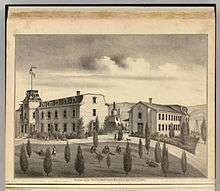Washington College (California)

Washington College, also called Washington College of Science and Industry, was a private coeducational secondary school established in 1871 near Washington Corners, later known as Irvington, now part of Fremont. It was one of the first technical schools in California. It later became an institution of the Disciples of Christ and in 1894 was succeeded by a girls' school, the Curtner Seminary. After a fire this was in turn succeeded by a military school for boys, Anderson Academy.
History
Washington College was built in 1871 on high ground above Washington Corners by the people of Washington Township as a scientific and industrial school, and opened the following year with the Reverend S. S. Harmon and his wife as teachers. Two of their daughters later taught there; Rev. Harmon later started a school in Berkeley.[1][2][3] It was coeducational and secular.[4] After a few years it ceased operations.[4]
One of the founders, and the owner of the land, was Henry Curtner, a local landowner and merchant. In August 1883, under a lease agreement with Curtner, it reopened as an institution of the Disciples of Christ, with J. Durham, Mr. Pollard, and J. H. McCollough as early leaders.[1] The college closed when President J. C. Keith retired in 1894.[5]
Washington College was described in the 1939 Federal Writers Project Guide to California as "one of the State's pioneers in industrial education".[6] On May 27, 1886, the San Francisco Bulletin described the curriculum as including "preparatory, scientific, classical and commercial courses."[7] By the 1890s it offered classical, scientific, Biblical, and artistic courses both at college level and in preparation for university entry.[8] Its college-level courses were the first offered in Alameda County.[9]
Successor institutions
In 1895 or 1896 Curtner opened Curtner Ladies' Seminary, a girls' school, in the college buildings under the leadership of H. C. Ingram and his wife, Ingar Stephenson-Ingram, both of whom had been teachers at the college.[1][5] Other Washington College faculty also continued to teach there.[10] According to a retrospective in the Oakland Tribune on April 15, 1953, there were accommodations for 52 students.[11] It began as a high school but later added a normal school course, which was much in demand at the time.[12] The main building burned down on the morning of July 4, 1899; since Ingar Ingram was seriously ill, the school did not reopen.[1][13]
In 1900, with the assistance of Irvington and nearby towns, William Walker Anderson built a new school on the site and moved his University Seminary, a military school for boys, from Alameda, renaming it Anderson's Academy.[1][10][14] A redwood gymnasium was designed by architect Charles E. Gottschalk.[15]
Anderson Academy closed in 1914 and the Anderson family used the site as their home, renaming it "Bonnie Brae".[16] In 1942 it was bought by the Giles family, whose land had been requisitioned by the Armed Services for Camp Parks.[17] Their estate, "Peacock Hill", was redeveloped for housing in the 1980s.[18]
Notable people
- Frank Chance, baseball player and manager[8][19]
References
- 1 2 3 4 5 Country Club of Washington Township, History of Washington Township, Alameda County, California, Washington Township, California: 1904, pp. 86–87.
- ↑ Philip Holmes and Jill M. Singleton, Irvington, Fremont, Images of America, Charleston, South Carolina: Arcadia, 2005, ISBN 9780738530055, p. 23.
- ↑ Mildred Brooke Hoover and Douglas E. Kyle, Historic Spots in California, 4th ed. Stanford, California: Stanford University, 1990, ISBN 9780804717342, p. 17.
- 1 2 E. B. Ware, History of the Disciples of Christ in California, Healdsburg, California: [F. W. Cooke], 1916, OCLC 4727361, p. 218.
- 1 2 Ware, p. 219.
- ↑ Federal Writers' Project of the Works Progress Administration of Northern California, California: A Guide to the Golden State, American Guide Series, New York: Hastings House, 1939, OCLC 10334636, p. 600; quoted in Holmes and Singleton, p. 71.
- ↑ Quoted in Holmes and Singleton, p. 24.
- 1 2 Gil Bogen, Tinker, Evers, and Chance: A Triple Biography, Jefferson, North Carolina: McFarland, 2003, ISBN 9780786416813, pp. 8–10.
- ↑ John Starbird Sandoval, The History of Washington Township, [Hayward, California]: Mt. Eden Historical Publishers, 1985, OCLC 565171514, p. 167.
- 1 2 Leland W. Cutler, America Is Good to a Country Boy, Stanford, California: Stanford University, 1954, OCLC 1942255, p. 32.
- ↑ Article by Gladys Williamson, cited in Holmes and Singleton, pp. 28–29; Holmes and Singleton give the opening year as 1895, Ware as 1896.
- ↑ Holmes and Singleton, p. 29.
- ↑ Holmes and Singleton, p. 32.
- ↑ Holmes and Singleton, p. 33.
- ↑ Holmes and Singleton, p. 35.
- ↑ Holmes and Singleton, p. 36.
- ↑ Holmes and Singleton, pp. 80–81.
- ↑ Holmes and Singleton, p. 97.
- ↑ Holmes and Singleton, p. 27.
Coordinates: 37°32′05″N 121°57′08″W / 37.5347°N 121.9523°W